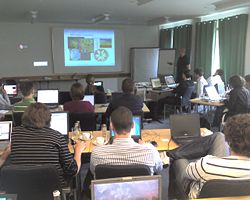Events:TutorialContestJan2009
Contents
Annnouncement of Winners for the Jan 2009 Contest
CONGRATULATIONS TO Winning contestants from each category who get the cash prizes courtesy of Kitware Inc.
University of North Carolina at Chapell Hill
- 2nd: $150 Non-human Primates Segmentation Tutorial
Virginia Tech
- 3rd: $100 Prostate Therapy Planning Tutorial
Brigham and Women's Hospital /University of Toronto
Background
Slicer3 is now being used to perform meaningful research tasks. As part of the NA-MIC Training Core activities we are building a curated portfolio of tutorials for the basic functions and functionality available in Slicer. Examples for such existing tutorials are the level 1 and 2 courses in the training compendium.
Next round: Tutorial Contest June 2009
Tutorial Contest Goal
The primary purpose of this contest is to enrich the training materials that are available to end-users and developers using 3D Slicer and the NA-MIC kit. We believe contestants will be motivated to participate to enhance the dissemination of their own algorithms that they have incorporated into the Slicer3 platform and/or to enhance training of Slicer3 functionality for their own laboratory groups.
There will be two categories:
- END TO END SOLUTION TUTORIAL: In this category, the tutorial will teach a user how to solve a particular clinical problem using the NA-MIC Kit. Entries into this category will require at least:
- materials about the scientific and application background and motivation,
- step-by-step guides, and
- sample data
- Example: Neurosurgical Planning for Image Guided Therapy using Slicer3
- ALGORITHM TUTORIAL: In this category the tutorial will teach a user how to make an algorithm work on their data. Entries into this category will require at least:
- materials about the scientific and application background of the algorithm(s) and their use in the Slicer environment
- step-by-step guides, and
- at least two different sample data sets from two different institutions
- Example: Automatic Segmentation Tutorial using Slicer3
Template
A basic template has been used for all of the tutorials. The same design should be used for the contest. It can be found here: Template
- Note: The examples above predate the template.
Rules
- Tutorial must be based on a snapshot or release of Slicer 3
- Tutorial must follow the guidelines specified above
- If applicable, provide clear directions for downloading and installing additional modules
- The tutorial and all of its components (data, powerpoints/pdfs, additional modules etc.) must be released under the Slicer license
- Applicants must agree to work with the NA-MIC Training and Dissemination Cores to curate their submission (we will test it on each of the available platforms and for usability and work with you to smooth any issues after the contest).
Dates
- Submission: Tuesday, January 6th, Midnight, Utah time (MST) (there will be no extensions)
- Review: Wednesday, January 7th
- Decisions announced: Thursday January 8th at NA-MIC All-Hands-Meeting
Judges
- Ron Kikinis
- Luis Ibanez
- Steve Pieper
- Randy Gollub
- Sonia Pujol
- Guido Gerig
Questions
Contact Training Core PI: Randy L. Gollub (rgollub at partners dot org)
Entries
NOTE THESE TUTORIALS ARE STILL UNDER DEVELOPMENT: Final versions will be posted on the Slicer 3 101 page with the rest of the training compendium
- Iowa Meshing Tutorial - Demonstrates the new hexahedral meshing capabilities Slicer3 using a proximal phalanx bone
- Non-human Primates Segmentation Tutorial - Virginia Tech - Demonstrates how to use Slicer3 for skull stripping and automatically segmenting non-human primate MR images.
- Prostate Therapy Planning Tutorial - Demonstrates how to use Slicer3 for MRI-guided prostate interventions, including clinical background, B-spline registration, manual segmentation and model making
- Basic Slicer3 Navigation Tutorial - Demonstration of navigation using OpenIGTLink, using a tracking simulator
- Python Stochastic Tractography Tutorial - Demonstrates the new stochastic tractography module of Slicer3 using a DWI image and a region of interest.
- UNC ARCTIC Tutorial in 2 parts - Demonstrates how to use ARCTIC to perform a regional cortical thickness analysis within Slicer3.
- Lupus Lesion Tutorial - Demonstrates how classify white matter lesions in lupus within Slicer3.
- Segmentation of the Orbit from the Cliniques Universitaires saint Luc Brussels Belgium- Demonstrates how to use Slicer 3 segmentation tools to label discrete anatomical compartments around the eye.
- Robotic IGT from University of Toronto

